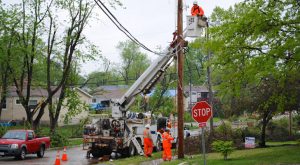
Investors should consider pivoting into utilities stocks in anticipation of lower rates later this year. It’s all a question of weighing current bond rates against utilities dividends and potential price appreciation. There’s a strong argument to be made that moving into utilities shares at the moment is an excellent option to take advantage of a shift that is likely to occur.
What I mean is this: As the Fed funds rate falls, so do bond yields. Currently, bond yields stand around 4.35%. Those returns are higher than those offered from utility stock dividends. That has caused many investors to move into bonds.
The Fed is probably going to lower rates in September. That will send bond yields lower, spiking demand for utilities stocks, and resulting in price appreciation. In short, invest in currently low-priced utilities stocks with higher dividends, take advantage of the income and anticipate price appreciation as I’ve just explained.
National Grid (NGG)

National Grid (NYSE:NGG) is a regulated electric company providing electricity transmission infrastructure and distribution services throughout the U.K. and parts of the U.S.
As with every investment, there are pros and cons. That’s also applicable to National Grid as an investment. The cons with the company are that its most recent results show top-line contraction. However, the company managed to squeeze more earnings from the difficult operating environment. Additionally, National Grid increased its dividend by 9% during the same period. That’s a strong indication the company continues to value shareholders overall.
The company doesn’t benefit from having any analyst coverage at the moment so it’s difficult to ascertain where the price may be going. However, National Grid stock has a strong share from the perspective of income generation. The dividend currently yields more than 4.8%. That’s higher than the 10-year treasury bond yield at the moment. The company also provides a semi-annual dividend, the much larger portion of which it pays in June of every year. So, it may be a good idea to take advantage of the opportunity with that timeframe in mind.
FirstEnergy (FE)

FirstEnergy (NYSE:FE) is very similar to National Grid in composition and what it offers to investors. The company distributes electricity but solely throughout the U.S. It currently offers a dividend yielding 4.2% which is very close to yields on 10-year treasury bills. Again, investors should anticipate those yields will fall at some point in 2024, likely September, or whenever the Fed lowers rates.
Investors have to look at more than dividends in judging whether to invest in a company like FirstEnergy. Share prices are of paramount importance. FirstEnergy currently trades for $40 and might move to $45 within the year. A bit of arithmetic shows that returns could exceed 16%, including $1.70 in annual dividends.
There’s certainly nothing wrong with that level of returns. In fact, it far exceeds the average 10% returns from the S&P 500 since its inception in 1957.
Evergy (EVRG)

Evergy (NYSE:EVRG) is a regulated electric utility headquartered in Kansas City and a stock to watch in relation to bond yields and Fed fund rates.
Let’s start with the simple comparison between its dividend yield and that of 10-year Treasury bills. Evergy is attractive from that perspective, with dividends currently yielding 4.62%, slightly outpacing T-bills. Share prices are also anticipated to move higher, perhaps by as much as $10 above the current $55 price.
Beyond those positives, there’s a lot to like about Evergy from a fundamental perspective. The company boasts strong gross margins, exceeding 80% of competitors. Overall, Evergy is a relatively profitable firm. However, the fundamental I wanted to talk about is the forward PE ratio. When the forward PE ratio is lower than the current PE ratio, that indicates an expectation of rising earnings. Fortunately, Evergy’s forward PE ratio is lower than its current PE ratio. There’s a lot to like about Evergy concerning the current macro environment.
Algonquin Power & Utilities (AQN)

Algonquin Power & Utilities (NYSE:AQN) is a renewable utilities stock serving multiple states in the U.S., parts of Canada and other countries. The company serves approximately 1.25 million customers, meaning it isn’t a particularly large utilities company. That is reflected in its share price, currently below $7.
Share prices are near the low expectation of analysts, suggesting substantial upside even at the base case. Those low prices also mean yields are quite high, currently at 6.5%. Higher dividend yields generally equate to greater risk levels. That is certainly true in the case of Algonquin Power & Utilities.
The company reduced its dividends to their current level in 2023. Dividend reductions are a clear indication of risk. Furthermore, the current payout ratio is slightly above one, indicating the potential for further reductions. I can’t find any clear indication of whether the earnings are expected to rise or not. Thus, I would warn potential investors that there is risk. But the fact that analysts remain positive should inspire some confidence.
PNM Resources (PNM)

PNM Resources (NYSE:PNM) appears to be undervalued at the moment, presenting the opportunity to capture strong returns.
A good part of the reason PNM Resources is undervalued relates to its most recent earnings report showing earnings per share have slipped. The company reiterated its earnings expectations for the year and analysts are still bullish on the stock, all of whom expect share prices to rise moving forward.
The company provides electricity to more than 800,000 homes and businesses in New Mexico and Texas. It also aims to provide emissions-free electricity by 2040.
The company’s dividend currently yields at 4%, so it is slightly less attractive than a current 10-year Treasury bill. However, share prices are expected to rise by as much as $13 above their current $38 price. Therefore, potential returns by investing in PNM Resources are substantially higher. The company last reduced its dividend in 2009, indicating it is reasonably dependable.
Eversource Energy (ES)

Eversource Energy (NYSE:ES) is among the most stable stock choices on this list. The company recently reported earnings, showing that EPS has increased during the first quarter. EPS increased from $1.41 to $1.49 as earnings jumped from $491.2 million to $521.8 million in the first quarter of 2024.
Strong earnings provided the company with the confidence to issue a 71.5-cent dividend and reaffirm earnings guidance for all of 2024. All of that suggests that Eversource Energy is a relatively stable firm. Some investors might be spooked by the fact that the company reduced its dividend in 2020. That’s not very long ago. However, Eversource Energy boasts a healthy payout ratio of 0.63.
If the company went through a rough patch a few years ago, it certainly seems to have found more stable footing today. Eversource Energy’s dividend yields 4.67%, which is very attractive for all of the reasons I’ve reiterated multiple times in this article.
Ameren (AEE)

Ameren (NYSE:AEE) provides electricity and gas distribution services in the Midwest states, including Illinois and Missouri. The stock includes a dividend yielding 3.6%, still strong despite being lower than many of the other options on this list. That yield is also lower than that available through Treasury bills at the moment.
Ameren makes up for that through share prices that could rise as high as $94, per analyst expectations. That’s particularly attractive given that the shares currently trade for $74.
First-quarter earnings fell from $264 to $261 million for the company. It attributed that decline to a number of factors, including warmer-than-anticipated weather. Despite the lower earnings, there are several reasons to remain optimistic about Ameren. For one, the company’s dividend is healthy, with a payout ratio of 0.61. It was last reduced in 2009. I also like that the company’s forward PE ratio is lower than its current PE ratio. Again, that suggests earnings will rise moving forward.
On the date of publication, Alex Sirois did not hold (either directly or indirectly) any positions in the securities mentioned in this article. The opinions expressed in this article are those of the writer, subject to the InvestorPlace.com Publishing Guidelines.





